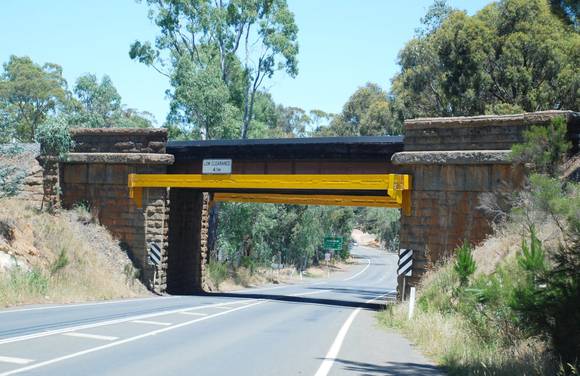| Back to search results » | Back to search page » |
|
HARCOURT RAILWAY PRECINCT (MURRAY VALLEY RAILWAY, MELBOURNE TO ECHUCA)
Other NameVICKS VIADUCT LocationSYMES ROAD HARCOURT, MOUNT ALEXANDER SHIRE
File Number608472LevelRegistered |
|
Statement of Significance
[See also H1433 Rail Bridge over Barkers Creek Harcourt] What is significant?
The Harcourt railway precinct forms part of the Murray Valley Railway (Melbourne to Echuca line). Opened in five stages from February 1859 to September 1864, the Murray Valley Railway was the largest of the Colony's first two main trunk lines. The inability of the line's original private promoters - the Melbourne, Mount Alexander and Murray River Company - to raise sufficient funds to construct the line, led to the government purchasing the company and embracing a public railway system. The Government's decision to construct the line in 1856 was accompanied by the formation of the Victorian Railways Department. The building of the line during the early 1860s reflected the strategic economic issues of the day: servicing the important goldfields of Castlemaine and Bendigo, and capturing the Murray River and Riverina trade for the Port of Melbourne. With a labour force of more than 6,000 men, the Melbourne to Echuca line was the Colony's largest capital works project of its time. The line is still used today for public transport and freight services and comprises a very large number of structures and facilities of varying ages, conditions and degrees of operational and business significance.
How is it significant?
The Harcourt railway precinct is of historical and scientific importance to the State of Victoria.
Why is it significant?
The Harcourt railway precinct (comprising the Midland Highway rail-overbridge, Vicks viaduct and associated embankment) is historically and scientifically significant as an integral part of the railway and is an important representative sample of one of the earliest and grandest capital works projects in Victorian history. The identified features comprising the precinct are all substantially intact and provide a crucial reminder of the adoption of English engineering and architectural standards and the role of the Victorian Railway Department in developing the Colony's engineering expertise.
Vicks viaduct has three main spans and is characterised by its deep arches and substantial abutments. Constructed of local quarried stone, Vicks viaduct is a rare example in Victoria of the use of granite for bridge building. The viaduct is a significant community landmark and its aesthetic qualities have made it the subject of many sketches, photographs and postcards. The solid granite structure is characteristic of the Harcourt section of the line, and the widespread use of local granite (from quarries on nearby Mount Alexander) on the line was a pioneering force behind the development of Harcourt's quarrying industry.
Vicks viaduct, along with the associated embankment and adjoining rail-overbridge,
are excellent examples of the range of materials, building techniques and design types used on the Kyneton to Bendigo section of the line. The precinct makes an important contribution to defining the character of the Victorian railway network.
Group
Transport - Rail
Category
Railway Bridge/ Viaduct






